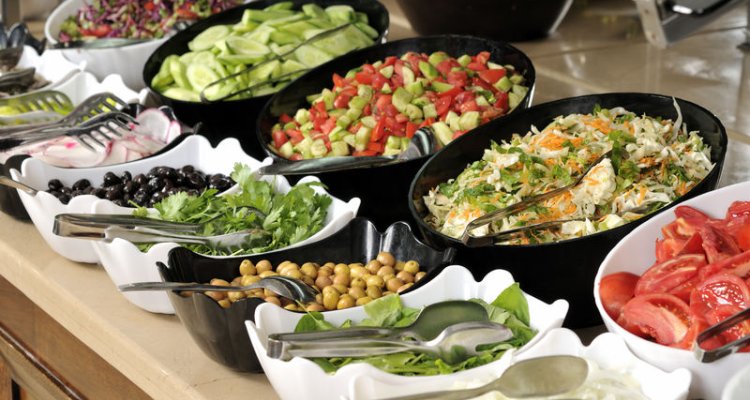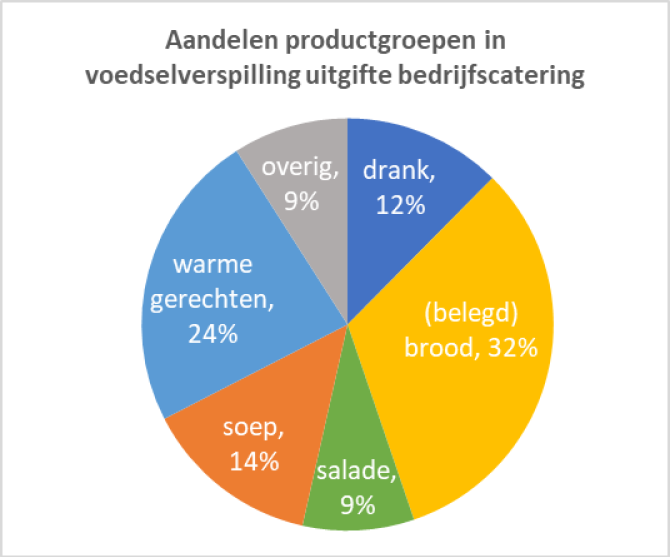
News
New insight in understanding of waste issues in corporate catering
From the wares dispensed by Dutch corporate caterers in restaurants of office buildings, educational institutions and factories, an average of 22 grams of food and beverages per guest goes uneaten. This is according to research conducted by caterers, the Dutch Catering Association (Veneca), Wageningen University & Research (WUR) and Samen Tegen Voedselverspilling (Food Waste Free United). Together, they provide insight into how much food is wasted within Dutch catering organisations. Monitoring is an important first step in combating food waste.
Clarifying waste figures together
To reduce food waste, it is important to first better understand the volume and composition of unsold food. In the project ‘ Waste-free catering’ of Food Waste Free United, the sector is jointly investigating this. Eight companies from the Dutch corporate catering industry are participating: Albron, Appèl, CIRFOOD, Compass Group, Food & I, Hutten, Vermaat and Vitam. The eight companies collectively provided data from over 1,500 locations over several months in the period January 2022 - July 2023. The data covers nearly 42 million guest transactions. From 1,000 sites, the data were suitable to base the benchmark per site on. Thanks to this research, there are now reliable figures on a significant proportion of waste at caterers.
Catering organisations willingly provided their waste data to researchers at WUR. The loss figures refer to what is unsold from dispensing (or displays). These products, although prepared, remain unsold and are recorded in the cash register systems or tracked through automatic weighing systems like Orbisk. WUR analysed this data and converted it into a gram-per-guest metric, providing a more accurate depiction of waste across various organisations and locations. For instance, it's logical that a corporate cafeteria serving 1,000 guests daily would generate more waste than a smaller venue with 25 visitors.
Results of the study about food waste in corporate catering

The results of this study deal only with the part of food waste that occurs at the point of dispensing. It thus concerns food and beverages that have already been prepared but not sold. Leftovers from dispensing correspond to about one third of the total food waste (Meier, Borstel, Welte, et al., 2021). Most of the food waste consists of: (topped) bread and hot dishes, together accounting for 56% of the loss in kilograms. Soups (14%) and salads (9%) have a smaller share today than 10 years ago when they still accounted for almost 50% of the loss from dispensing (Soedthout, 2012). The initiatives taken by caterers in recent years to reduce losses therefore appear to be yielding positive results.
Food waste in corporate catering
Corporate caterers provide food and beverages in various places, such as in the company restaurant or at school, banqueting for meetings and daily meals for patients or inmates. At various times, food is lost in the process and food waste is created. For instance, products go out of date, kitchen scraps are created during preparation, not all prepared products are sold at the counters and displays, there are often leftovers from meeting lunches and some are left on plates. It is very interesting to find out more about when food waste occurs, because this helps organisations get a grip on the causes and implement solutions.
Follow-up: getting started with banqueting
Proven tips & tricks to prevent waste in catering will be picked up in the coming period to help other caterers. In addition, the caterers have agreed with each other to add more levels of depth to the waste monitor in the coming year. By doing so, they aim to provide a more complete picture of the overall food waste within corporate catering and what organisations can do about this.
This will include the waste created by pre-ordered banqueting (including meeting lunches). With more insight into the occurrence of food waste, organisations can address food waste more effectively. For example, by having more insight into whether the waste occurs at dispensing, banqueting or preparation. A breakdown by location type will improve insights into causes of waste. This will require collecting more specific data.
The final results should lead to tools to concretely address causes of food waste at locations. Caterers' clients are expected to play an important role in this, for instance by paying more attention to food waste in the ordering process.
The 'waste-free catering' project
The 'Waste-free Catering' project has been made possible with funding from the SCALE12.3NL project. SCALE12.3NL is funded by the European Union and co-funded by the Ministry of Agriculture, Nature and Food Quality of the Netherlands. Are you a caterer and would you like your company to join the Waste-Free Catering project? Please contact us.